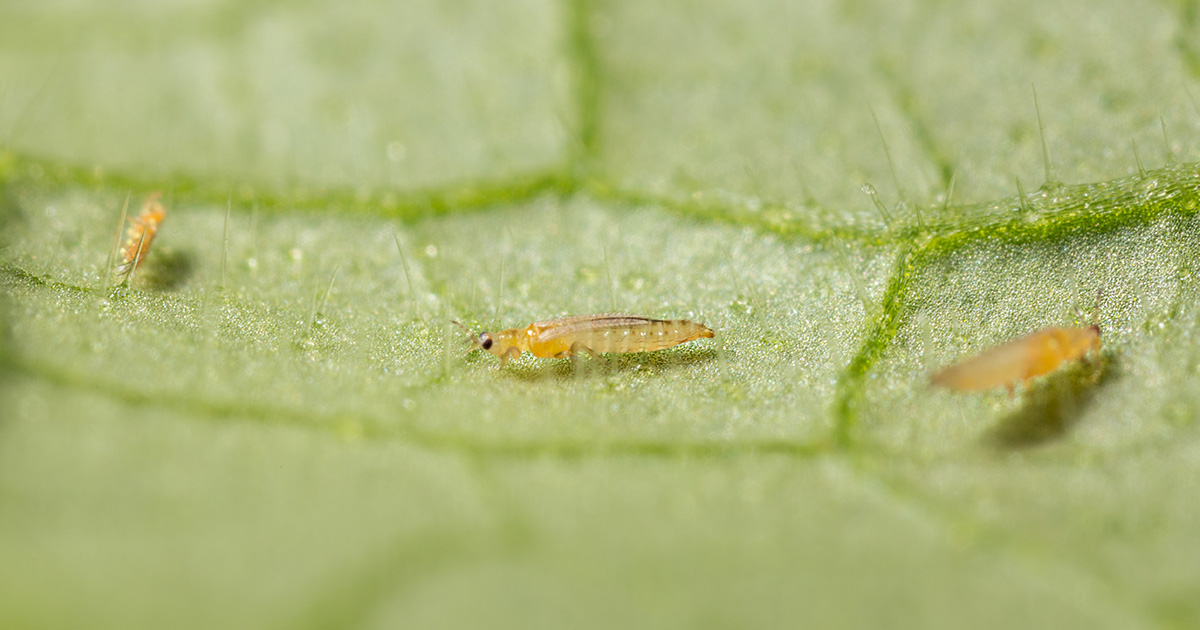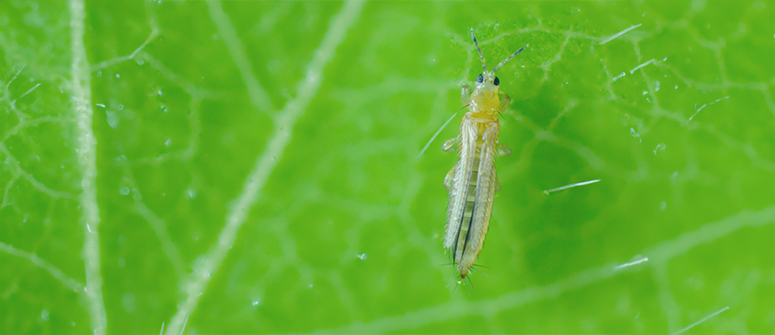BH
Tha Dank Hoarder
Western Flower Thrip / Frankliniella Occidentalis Info
View attachment 103141
View attachment 103140
View attachment 103142 View attachment 103143 View attachment 103144
View attachment 103145
View attachment 103146
View attachment 103148
"
Thrips are little insects that puncture into plants and sucking out the contentes. Depending on which stage in their life cycle thrips have reached they can be easily spotted by the naked eye. Fully matured they measure roughly 1-2 mm in length and although they may sound small and insignificant, left untreated thrips can cause serious problems, proving to be especially damaging during the early stages of your cannabis plants' growth.
The most common species to be found on cannabis is “Frankliniella Occidentalis”, commonly known as Tobbaco Thrips, and while solace can be taken in the fact that caught early enough the damage is not permanent, thrips attack a variety of plants, not just cannabis. To make matters worse, thrips can also fly, which makes it easy for them to move from one plant to the next, whether that be from marijuana plant to marijuana plant or a fruit or vegetable plant to your cannabis."
"
Western flower thrips have 6 life stages. The larval and adult stages actively feed on plants.
Egg- Thrips eggs are deposited into plant stems, petioles, and leaves by females using a saw-like ovipositor.
Duration- 2 to 4 days
Larval instar 1- Thrips larvae do not have wings when they emerge, but are able to feed on the plant.
Duration:
Larval instar 2- The second larval instar is larger than the first, feeding on the plant before entering the pupal stage.
Duration:
Pro-, and pupa stage- The larva normally drop to the soil to pupate. However, they can pupate on the host plant in ‘complex floral architecture’. The pupal stages do not feed.
Duration: 1 to 3 days
Adult- Winged adults emerge after pupation, ready to feed and looking to oviposit eggs.
Duration: Over 30 days, depending on environment."

 naturalenemies.com
naturalenemies.com
"
Initial signs of a thrips infestation will be small silvery trails left across the leaves of your cannabis. Similar to the mark left behind by a snail, the markings will be accompanied by yellowing or browning of the edges of the leaves. Thrips damage the outer layer of the plant structure by rasping the leaf and sucking the sap out. Left untreated, leaves becoming deformed and will start dying.
If the thrips have reached their fully matured form, then you may also be able to spot them crawling about on the plant itself. Careful observation is required as they are naturally good at camouflage, but if they have reached the point where they are visible, then the chances of incurring losses are high.
You want to deal with them as quickly as possible. It is worth noting that eventhough scars on leaves seem small, they grow with the leaf to form stretchmarks which will occupy a larger are"

 www.cannaconnection.com
www.cannaconnection.com
The primary mechanisms for virus increase in plant populations is by the thrips vector and dissemination of infected somatic tissue in vegetatively propagated crops. Transmission of the virus through plant seed is not recognized as a significant factor in the epidemiology of tospoviruses. These viruses are thought to move long distances in thrips carried by wind currents. They may also survive in commercial agricultural systems in weeds that serve as a bridge between crops. Secondary spread within a crop can only occur in crops that support virus infection and reproduction of the vector as only the larval stage can acquire the virus for transmission. The recent emergence of these viruses as serious pathogens in crops has been attributed to the increased prevalence of thrips as agricultural pests on a worldwide basis. For example, F. occidentalis, the western flower thrips, is a highly efficient vector of several tospoviruses. Its emergence in the floral crop industry was closely followed by the emergence of INSV in the late 1980s."
"
The process of successful acquisition occurs only by larvae and acquisition rates decrease as larvae develop, affecting adult vector competency. Vector competency is also determined by the thrips’ feeding preference on a particular host, the uniformity of distribution of virus in plant cells, the rate of virus replication in the midgut, and the extent of virus migration from the midgut to the visceral muscle cells and the salivary glands. In some instances the virus can be acquired by adult thrips and infects midgut cells, but is unable to spread further possibly due to the formation of an age-dependent midgut barrier (e.g., basal lamina). Research has shown the existence of thrips transmitters with detectable levels of virus, nontransmitters with detectable virus, and nontransmitters with no detectable virus, supporting multiple sites for vector specificity between tospovirusesand thrips. Evidence for replication of the virus in the insect vector is based on the accumulation of NSs and the visualization of viral inclusions in midgut epithelial cells, muscle cells, and the salivary glands. Although the virus is maintained transtadially throughout the life of the insect, there is no evidence for transovarial transmission. Thus, each generation of thrips must acquire the virus during the larval stages.
The primary dispersal of tospoviruses is by adult thrips and dissemination of infected somatic tissue in vegetatively propagated crops. These viruses are thought to move long distances in thrips carried by wind currents. They may also survive in commercial agricultural systems in weeds that serve as a bridge between crops. Infected summer weeds (e.g., in NC I. purpurea, I. hederacea, M. verticillata, A. palmeri, C. obtusifolia, R. scabra, Ambrosia artemisiifoliaL., Polygonum pensylvanicum L., and Chenopodium album L.) are the principal source for spread of TSWV to winter annual weeds, from which the virus is spread to susceptible crops in spring. Secondary spread within a crop can only occur in crops that concomittantly support virus infection and reproduction of the vector as only the larval stage can acquire the virus for transmission. Transmission through plant seed and pollen has not been conclusively demonstrated. The emergence of these viruses as serious pathogens in crops has been attributed to the increased prevalence of F. occidentalis as an agricultural pest on a worldwide basis"
 www.sciencedirect.com
www.sciencedirect.com
Worth reading and good information:

 www.ncbi.nlm.nih.gov
www.ncbi.nlm.nih.gov

 naturalenemies.com
naturalenemies.com

 agpestcontrol.net
agpestcontrol.net
---
IPM + knockout info coming soon! (late)
View attachment 103147
----
View attachment 103141
View attachment 103140
View attachment 103142 View attachment 103143 View attachment 103144
View attachment 103145
View attachment 103146
View attachment 103148
"
Thrips are little insects that puncture into plants and sucking out the contentes. Depending on which stage in their life cycle thrips have reached they can be easily spotted by the naked eye. Fully matured they measure roughly 1-2 mm in length and although they may sound small and insignificant, left untreated thrips can cause serious problems, proving to be especially damaging during the early stages of your cannabis plants' growth.
The most common species to be found on cannabis is “Frankliniella Occidentalis”, commonly known as Tobbaco Thrips, and while solace can be taken in the fact that caught early enough the damage is not permanent, thrips attack a variety of plants, not just cannabis. To make matters worse, thrips can also fly, which makes it easy for them to move from one plant to the next, whether that be from marijuana plant to marijuana plant or a fruit or vegetable plant to your cannabis."
"
Western flower thrips have 6 life stages. The larval and adult stages actively feed on plants.
Egg- Thrips eggs are deposited into plant stems, petioles, and leaves by females using a saw-like ovipositor.
Duration- 2 to 4 days
Larval instar 1- Thrips larvae do not have wings when they emerge, but are able to feed on the plant.
Duration:
Larval instar 2- The second larval instar is larger than the first, feeding on the plant before entering the pupal stage.
Duration:
Pro-, and pupa stage- The larva normally drop to the soil to pupate. However, they can pupate on the host plant in ‘complex floral architecture’. The pupal stages do not feed.
Duration: 1 to 3 days
Adult- Winged adults emerge after pupation, ready to feed and looking to oviposit eggs.
Duration: Over 30 days, depending on environment."

by Pest - Thrips | Natural Enemies Organic Chemical-Free Pest Control
Shop Certified Organic Thrips Products. Natural Enemies Organic Chemical-Free Pest Control
"
Initial signs of a thrips infestation will be small silvery trails left across the leaves of your cannabis. Similar to the mark left behind by a snail, the markings will be accompanied by yellowing or browning of the edges of the leaves. Thrips damage the outer layer of the plant structure by rasping the leaf and sucking the sap out. Left untreated, leaves becoming deformed and will start dying.
If the thrips have reached their fully matured form, then you may also be able to spot them crawling about on the plant itself. Careful observation is required as they are naturally good at camouflage, but if they have reached the point where they are visible, then the chances of incurring losses are high.
You want to deal with them as quickly as possible. It is worth noting that eventhough scars on leaves seem small, they grow with the leaf to form stretchmarks which will occupy a larger are"

How to identify and deal with thrips on cannabis plants - CannaConnection
Plagued by thrips? Read our definitive guide on how to spot and treat thrip infestations. Left alone these tiny insects do significant damage to your plants.
TOSPOVIRUSES (BUNYAVIRIDAE)
James W. Moyer, in Encyclopedia of Virology (Second Edition), 1999Transmission and Epidemiology
Tospoviruses are transmitted from plant to plant by a small number of thrips species. Among the more common vectors are Frankliniella occidentalis, F. fusca, F. schultzei, Scirtothrips dorsalis, Thrips palmi, T. setosus and T. tabaci. Thrips feed on the cytoplasm of plant cells. The contents of infected cells are ingested and the virus is transported along the lumen of the digestive tract to the midgut. The virus is then transported by endocytosis across the membrane of endothelial cells which line the midgut of the thrips. This process of acquisition only occurs in thrips in the larval stage of development. Evidence for replication of the virus in the insect vector is based on the accumulation of nonstructural protein (NSs) and the visualization of other inclusions in endothelial cells, muscle cells and the salivary glands. Viral inoculum is introduced into plants in the insect saliva coincident with feeding on the plant. Although the virus is maintained trans-stagially throughout the life of the insect, there is no evidence for transovarial transmission. Thus, each generation of thrips must acquire the virus during the larval stage of development.The primary mechanisms for virus increase in plant populations is by the thrips vector and dissemination of infected somatic tissue in vegetatively propagated crops. Transmission of the virus through plant seed is not recognized as a significant factor in the epidemiology of tospoviruses. These viruses are thought to move long distances in thrips carried by wind currents. They may also survive in commercial agricultural systems in weeds that serve as a bridge between crops. Secondary spread within a crop can only occur in crops that support virus infection and reproduction of the vector as only the larval stage can acquire the virus for transmission. The recent emergence of these viruses as serious pathogens in crops has been attributed to the increased prevalence of thrips as agricultural pests on a worldwide basis. For example, F. occidentalis, the western flower thrips, is a highly efficient vector of several tospoviruses. Its emergence in the floral crop industry was closely followed by the emergence of INSV in the late 1980s."
"
Transmission and Epidemiology
Tospoviruses are transmitted from plant to plant by at least ten thripsspecies in the genera Frankliniella, Scirtothrips, and Thrips. Among the more common vectors are Frankliniella occidentalis, F. fusca, F. schultzei, F. intonsa, F. bispinosa, Thrips palmi, T. setosus, and T. tabaci. Thrips feed on the cytoplasm of plant cells. The contents of infected cells are ingested and the virus is transported along the lumen of the digestive tract to the midgut, the primary binding and entry site into the insect cells. The brush border of the midgut lumen is the first membrane barrier that the virus encounters. The virus replicates in the midgut and crosses the basement membrane into the visceral muscle cells. The virus subsequently enters the primary salivary glands. It has been hypothesized that the virus moves from the midgut to the salivary glands through infection of ligament-like structures, or when there is direct contact between membranes of the visceral muscles and the primary salivary glands during the larval stages of development. A less plausible hypothesis is that the virus infects the salivary glands after entry and circulation in the hemocoel. Viral inoculum is introduced into plants in the insect saliva coincident with feeding on the plant by adult thrips.The process of successful acquisition occurs only by larvae and acquisition rates decrease as larvae develop, affecting adult vector competency. Vector competency is also determined by the thrips’ feeding preference on a particular host, the uniformity of distribution of virus in plant cells, the rate of virus replication in the midgut, and the extent of virus migration from the midgut to the visceral muscle cells and the salivary glands. In some instances the virus can be acquired by adult thrips and infects midgut cells, but is unable to spread further possibly due to the formation of an age-dependent midgut barrier (e.g., basal lamina). Research has shown the existence of thrips transmitters with detectable levels of virus, nontransmitters with detectable virus, and nontransmitters with no detectable virus, supporting multiple sites for vector specificity between tospovirusesand thrips. Evidence for replication of the virus in the insect vector is based on the accumulation of NSs and the visualization of viral inclusions in midgut epithelial cells, muscle cells, and the salivary glands. Although the virus is maintained transtadially throughout the life of the insect, there is no evidence for transovarial transmission. Thus, each generation of thrips must acquire the virus during the larval stages.
The primary dispersal of tospoviruses is by adult thrips and dissemination of infected somatic tissue in vegetatively propagated crops. These viruses are thought to move long distances in thrips carried by wind currents. They may also survive in commercial agricultural systems in weeds that serve as a bridge between crops. Infected summer weeds (e.g., in NC I. purpurea, I. hederacea, M. verticillata, A. palmeri, C. obtusifolia, R. scabra, Ambrosia artemisiifoliaL., Polygonum pensylvanicum L., and Chenopodium album L.) are the principal source for spread of TSWV to winter annual weeds, from which the virus is spread to susceptible crops in spring. Secondary spread within a crop can only occur in crops that concomittantly support virus infection and reproduction of the vector as only the larval stage can acquire the virus for transmission. Transmission through plant seed and pollen has not been conclusively demonstrated. The emergence of these viruses as serious pathogens in crops has been attributed to the increased prevalence of F. occidentalis as an agricultural pest on a worldwide basis"
Frankliniella occidentalis - an overview | ScienceDirect Topics
Worth reading and good information:

A global invasion by the thrip, Frankliniella occidentalis: Current virus vector status and its management
Western flower thrip, Frankliniella occidentalis (Pergande), is among the most economically important agricultural pests globally, attacking a wide range of vegetable and horticultural crops. In addition to causing extensive crop damage, the species is ...

by Pest - Thrips | Natural Enemies Organic Chemical-Free Pest Control
Shop Certified Organic Thrips Products. Natural Enemies Organic Chemical-Free Pest Control
Thrips Management Guidelines--UC IPM
UC home and landscape guidelines for control of Thrips.
ipm.ucanr.edu

Organic Pest Control Forest Heights OR | Ant & Garden Pest Control
Organic pest control in Forest Heights Portland and surrounding metro areas! Same-day ant removal. No Pest Guarantee! Free consultation!
---
IPM + knockout info coming soon! (late)
View attachment 103147
----